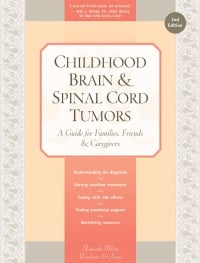Childhood Brain and Spinal Cord Tumors
Who gets central nervous system tumors?
More than 4,000 children younger than age 20 are diagnosed with brain or spinal cord tumors in the United States each year. Because there are many different kinds of brain and spinal cord tumors, the number of children diagnosed with each particular type is small. The incidence of childhood brain and spinal cord tumors is higher in males than females, and higher among white children than any other racial/ethnic group.
Genetic factors
Most brain and spinal cord tumors occur randomly and have no apparent cause. They are, however, associated with several inherited syndromes such as Von Recklinghausen neurofibromatosis, tuberous sclerosis, Turcot syndrome, Li-Fraumeni syndrome, and von Hippel-Lindau syndrome. Children with these genetic conditions have a greatly increased risk for developing brain tumors. Together, however, they account for less than 5 percent of childhood brain and spinal cord tumors. Because of their high risk for tumors, children with these conditions get periodic MRI scans and other evaluations to check for tumors.
Environmental factors
Very little is known about environmental causes of brain or spinal cord tumors. The best-documented cause of brain tumors is previous radiation to the brain. The risk of a second brain tumor increases with the dose of radiation received.
Other environmental factors, such as electromagnetic radiation and pesticide exposure, have not been confirmed as causes of brain and spinal cord tumors. Many research studies have evaluated possible environmental causes, but no conclusive results have yet been found.
Table of Contents
All Guides- Introduction
- 1. Diagnosis
- 2. The Brain and Spinal Cord
- 3. Types of Tumors
- 4. Telling Your Child and Others
- 5. Choosing a Treatment
- 6. Coping with Procedures
- 7. Forming a Partnership with the Treatment Team
- 8. Hospitalization
- 9. Venous Catheters
- 10. Surgery
- 11. Chemotherapy
- 12. Common Side Effects of Chemotherapy
- 13. Radiation Therapy
- 14. Peripheral Blood Stem Cell Transplantation
- 15. Siblings
- 16. Family and Friends
- 17. Communication and Behavior
- 18. School
- 19. Sources of Support
- 20. Nutrition
- 21. Medical and Financial Record-keeping
- 22. End of Treatment and Beyond
- 23. Recurrence
- 24. Death and Bereavement
- 25. Looking Forward
- Appendix A. Blood Tests and What They Mean
- Appendix C. Books and Websites

